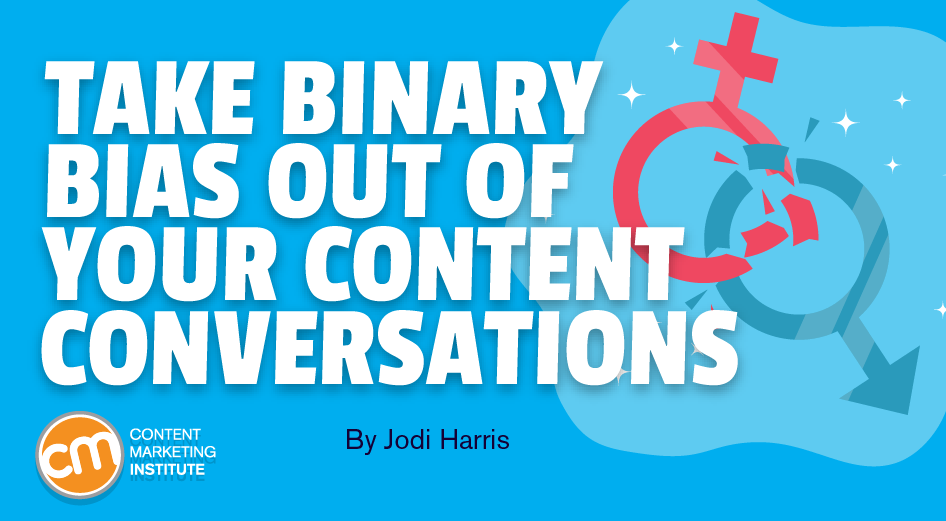
It’s a basic principle in marketing – create content that lets your audience know that your brand sees and hears them.
Optimizing your content conversations to be inclusive of transgender, nonbinary, or gender-nonconforming consumers will help you have a better chance of capturing their attention, deepening their engagement, and earning their loyalty. You also will gain respect from their supporters.
At Content Marketing World 2021, Ruth Carter – author, lawyer, and principal/“evil genius” at Carter Law Firm – spoke on the inclusion of nonbinary consumers in your content conversations. You can watch this follow-up interview with Ruth, then read on for additional insights, examples, and ideas from them to help you get started.
A small but influential community
Recent research shows than estimated 1.2 million adults in the U.S. are nonbinary – meaning they do not identify as strictly male or female. Given the nature of gender diversity and the linguistic, cultural, and societal norms associated with the topic, this is likely an underestimation.
Though other studies indicate their numbers may be on the rise – particularly as younger generations reach adulthood – they are a small minority of the estimated 334 million people in the U.S. While a small percent of the population, the nonbinary-inclusive audience also encompasses a large community of allies who support them and stand up for their rights.
A Public Religion Research Institute study found 76% of people support a law that says someone can’t discriminate against a person because of their gender, sexual orientation, or both. “Your company or your client may not care about [this tiny little group], but I bet they care about 76% of the audience they are trying to cater to. That’s what you’re risking by inadvertently or blatantly being discriminatory,” Ruth says.
76% of people support a law that says someone can’t discriminate based on gender, sexual orientation, or both, says @PRRIPol via @rbcarter @joderama @CMIContent @semrush. Click To Tweet
Consider the experience of Confections, a Texas-based bakery Confections, and its Facebook post wishing their LGBTQ friends a happy Pride Month:
The local community of LGBTQ+ supporters took it as a call to action – and answered it in droves. A day later, Confections shared a new post to give thanks for all the love and support – and announce they sold out their cookie inventory:
Transgender and nonbinary audiences, as well as inclusivity advocates, remember which companies actively welcome their business, says @rbcarter via @joderama @CMIContent @semrush. Click To Tweet
5 steps to evolve your content beyond binary boundaries
Trans and nonbinary people want to see their full, authentic selves represented in a brand’s experiences. While gender identity is a complex, personal, and evolving topic, making your content feel more welcoming and accepting of the nonbinary experience isn’t nearly as complicated.
In their presentation, Ruth suggests simple changes brands can make to acknowledge their unique experiences and ensure equal consideration.
1. Explore your brand experience through a nonbinary lens
If your content focuses on the male-female gender experience (Ruth describes this as “that 1950s stereotype of what a man is and what a woman is”), you exclude the perspectives of people who don’t fit those constructs.
If your #content focuses on the male-female gender experience, you exclude people who don’t fit those constructs, says @rbcarter via @joderama @CMIContent @semrush. Click To Tweet
To communicate more inclusively, put yourself in the shoes of somebody who doesn’t identify as male or female and walk through their customer journey. “Think about how they might experience [a brand] differently than a cisgendered audience and see if there are opportunities to shift to a [different] perspective,” Ruth says.
For example, clothing brand Levi’s announcement of its “genderless” Unlabeled Collection shifts the conversation by defining gender as being really confident in who you are and feeling free to identify yourself by name, not by a label of male or female.
2. Update your style bible, registration forms, and greetings
When you reference an individual in the third person, do you only use he/him, she/her pronouns? “What this phrasing communicates to me is that I don’t exist. I don’t deserve to be part of this community,” says Ruth, who recommends replacing these exclusionary terms with they/them pronouns. Incorporate the use of pronouns in your style guide and ensure your content team is aware of the change.
Gender bias often lurks in how speakers address audiences in group settings, such as an event or livestreaming video. Ruth says instead of starting with “Ladies and gentlemen,” go with a greeting like, “Welcome, everyone.” Brands can take this to the next level by creating a custom, gender-neutral term for your audience like the Green Bay Packers do with Cheeseheads to refer to its fans.
Similarly, the use of traditional honorifics like Mr., Mrs., or Ms. excludes trans and nonbinary people. If you use drop-down menus or checkboxes on your registration forms to collect gender demographics, make sure you include MX (pronounced “mix”) as a gender-neutral honorific option.
New Zealand telecommunications company Spark addresses this issue by changing how businesses collect gender data. Its Beyond Binary Code campaign (below) introduces a single piece of code that enables standard website forms to be updated to a more gender-inclusive alternative. They co-created it with OutLine Aotearoa, a mental health organization, and nonbinary communities.
ADVERTISEMENT
The State of Content Marketing 2022 Global Report
500K articles analyzed. 1,500 marketers surveyed. 9 experts interviewed. Download the biggest industry report by Semrush and explore thousands of data points to build a better content marketing strategy.
3. Make it easy to access and update their personal data
Speaking of data collection, Ruth points out that trans and nonbinary consumers may have used their birth-assigned name and gender when they created their original account with your business. Empower those who have later updated their name to affirm their authentic identity in your records. Be clear about any documentation required for validation purposes – i.e., if there are legal, financial, or other regulatory requirements involved.
Mastercard took a different approach to address the binary data dilemma: In 2020, the brand launched its True Name feature, which enables financial institutions to issue credit cards that display the customer’s first name – without requiring documentation to prove it was a legal name change. According to the company’s news release, their director of consumer marketing Anthony DeRojas conceived the initiative as a meaningful way to commemorate World Pride and the 50th anniversary of the Stonewall Riots. “We wanted to go beyond being just a logo in a sea of other Pride sponsors,” says DeRojas. “We wanted to do something that was impactful for the community.”
It may seem like a small gesture, but it makes a big difference to customers like Asher: “Seeing a name you connect with feels like acceptance … being seen and acknowledged as the person you are … It will change lives.” As a bonus, the spot’s tagline Start Something Priceless fits in with the brand’s signature #Priceless hashtag.
HANDPICKED RELATED CONTENT:
4. Consider whether gender is contextually relevant to the story
Ruth advises marketers to refer to interview subjects and other sources by their preferred pronouns. (If you aren’t sure, ask them.) However, it’s not always necessary – or appropriate – to incorporate their gender identity in your storytelling. “I was on NPR, talking about how Arizona now issues nonbinary driver’s licenses. It made sense that my gender would be identified. But if it was me talking about trademark law, my gender would be pretty irrelevant,” Ruth says.
You also can incorporate gender inclusivity by featuring a wider range of personal experiences in your content or amplifying inclusivity on your media channels. It’s an approach that Pantene used in this emotionally powerful video celebrating LGBTQ+ pride in all its forms.
5. Listen to their conversations
Your audience often tells you what they need and want to see – you just need to pay attention.
As I mentioned earlier, transgender and nonbinary people often change their birth name to one that better suits who they are. Starbucks picked up on a discussion on social media about whether they’ve selected the right name. It responded with a way to try out their chosen name and see how it feels:
HANDPICKED RELATED CONTENT:
Small step for your brand can be a giant leap for inclusion
To communicate more inclusively and forge stronger customer connections, eliminating gender bias from your brand’s conversations is a critical first step. For nonbinary people who have often felt ignored or invisible to brands, even making small adjustments to the language, syntax, and substance of your content conversations can be affirming and validating. As Ruth points out, your business doesn’t have to become an authority on the complicated subject of gender – it just takes an authentic desire to be part of the conversation.
HANDPICKED RELATED CONTENT:
Cover image by Joseph Kalinowski/Content Marketing Institute





